Arowana fish
Arowana Fish (sometimes called dragon fish) can be a great choice for those that think big. Some varieties can grow up to Four feet long (120cm). They can be feisty, though become tamer with age to the point of eating from your fingers, and not the fingers themselves. The Arowana Fish comes from somewhat primitive origins (Jurassic Age), and some varieties are nicknamed “Bony Tongued Fish”.
Arowana fish are carnivores, though will generally eat nearly anything. Young Arowana Fish may be fed frozen or live brine shrimp, black worms, and even small fish. When older, some larger fish will do. Baby Arowana Fish should be fed maybe 3 times a day, medium sized twice a day, and adults once a day, or even once every other day. Variety is important for a well balanced diet in Arowana Fish just like for most other fish.
The Arowana eating habits produce a lot of waste and you should therefore, pay extra attention to water conditions (Ammonia, Nitrite, and Nitrate) in your aquarium. Changing 25% to 33% of the water weekly is advisable, or better yet, 20% twice a week. You should maintain the pH neutral. Pay particular attention to the temperature and pH ranges suggested below on the various species, since if you have it too warm, it might cause them to age faster, look less Arowana, and even shorten their life. A to cold temperature might on the other hand kill them.
Generally, a good healthy Arowana Fish will grow to be at least 24 to 30 inches (60-75cm). Some varieties can become 48 inches (120 cm) in the wild. They may be aggressive (definitely not good community fish), and Arowana fish can sometimes be best kept alone in an aquarium. Remember that other smaller fish in the tank may become their dinner.
Arowana fish will often swim in the top of the aquarium, and are capable of jumping from the aquarium. Keep the aquarium well covered to avoid coming home to a dead pet. Silver Arowana Fish in the wild have been known to jump at insects in trees.
Arowana Fish may live for many years, and if well cared for Arowana fish may live longer than 20 years in captivity. If you keep the aquarium temperature towards the lower end, they may look young longer than they would in a higher temperaturel. Please pay particular attention to each Arowana Fish’s needs below.
The Asian Arowana or Golden Arowana (Scleropages formosus) is considered an endangered species. Care should be taken to follow the law in purchasing and transporting them. Asian Arowana fish generally can grow to about 36 inches, and are often much more expensive then the other Arowana species. These are well known and popular South East Asia where they are believed to bring luck. Feeding them healthy Guppies, Gold Fish, Frogs, or Shrimp makes a good stable diet. The temperature is best kept between 75 and 86 degrees Fahrenheit (24-30 C), and a pH level between 7.0 and 7.5 are advisable.
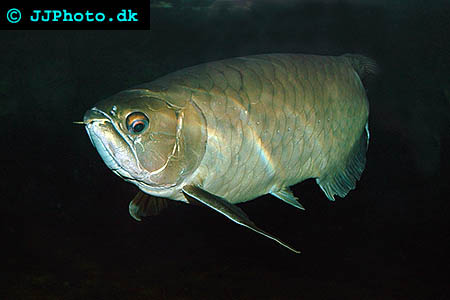
Asian Arowana - Scleropages formosus. Copyright www.jjphoto.dk
The Silver Arowana (Osteoglossum bicirrhosum) comes from the Amazon Basin. They can grow to around 48 inches in the wild, and are usually the cheapest Arowana species. Silver Arowana can be more jumpy then the other species and more than one Silver Arowana have jumped to their death in a badly covered aquarium.
Silver Arowana may take a while to adjust to non-live food. Sometimes to the brink of starvation. Feed them meaty food like, fish, crab, or Shrimp (try to avoid the salt). This Arowana Fish thrives in temperatures between 75 and 86 degrees Fahrenheit (24-30 C), and pH between 6 and 7. Young Silver Arowana should not be in a tank shorter then 36 inches/ 90 cm, and as they get older, 48 inches/ 120 cm though when your Arowana fish reaches 15 inches/ 40 cm they will need a much larger tank. These Arowana Fish can become aggressive towards similar species and should be kept alone in the aquarium tank unless it is very big. They can also be kept with larger catfish and a few other species. They are a definitely predator and will eat smaller fish. As juveniles, they may be suitable for smaller home aquarium, though with growth, they are likely to outgrow the home and become suitable only for large public aquariums.
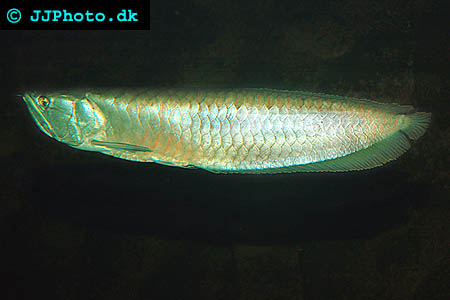
Silver Arowana - Osteoglossum bicirrhosum. Copyright www.jjphoto.dk
The Spotted Arowana (Scleropages leichardti) is mostly found from Southern Australia. They can grow to around 36 inches/ 90 cm (they do however only seldom reach this length in an aquarium), and are less sought after then the Asian Arowana. They are also called Dawson River Saratoga, Southern Saratoga, Spotted Barramundi, Australian Spotted Arowana, and Leichardti Saratoga. They tend to stay closer to the bottom than other Arowana fish species. This means that it sometimes is possible to keep them with Silver Arowana fish. As far as food, they are capable of eating most things that will fit their mouth (crickets, Hikari pellets, insects, etc). This Arowana fish species prefers a temperatures between 75 and 86 degrees Fahrenheit (24-30 C), and a pH level between 6.5 and 7.5. They may be territorial and aggressive.
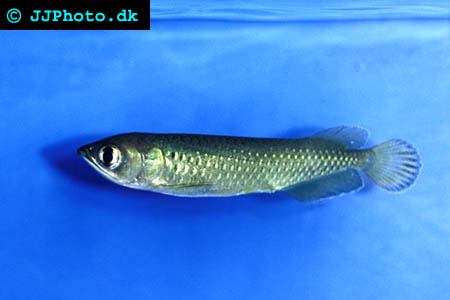
Spotted Arowana - Scleropages leichardtii. Copyright www.jjphoto.dk
The Northern Arowana (Scleropages jardini) is found mostly in Northern Australia. They can grow to around 36 inches/ 90 cm. They are also called Northern Saratoga, Jardine Saratoga, Gulf Saratoga, Australian Gold or Pearl Arowana and Jardini Saratoga. They eat similar food as the Spotted Arowana (Southern Australia), and are less likely to jump out of the tank than other species (though they might). This variety of Arowana Fish is best kept at a pH level of 6.0 - 7.5 and temperatures of 72 to 80 degrees Fahrenheit (22-27 C). While less aggressive then others, they are still predators and will likely eat anything that will fit in their mouths. They will eat Crayfish, Fish, Insects, and pellets with a little effort to get them started.
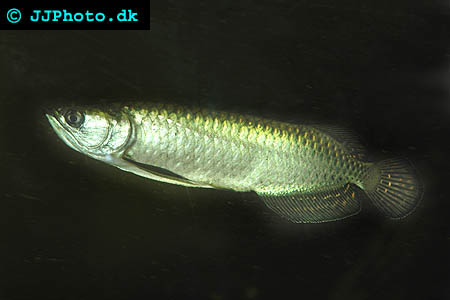
Northern Arowana - Scleropages jardinii. Copyright www.jjphoto.dk
The African Arowana (Heterotis niloticus) comes from western and central Africa. They grow up to around 40 inches/100 cm. They are more rare than other Arowana Fish species. They are predators known to eat small fish. This Arowana Fish prefers temperatures between 75 and 86 degrees Fahrenheit (24-30 C) and a pH level of 6.7 to 7.5 (7.0 preferred). They eat shrimp, fish, live worms, and insects in captivity.
The Black Arowana fish (Osteoglossum ferreirai) comes from South America in the Rio Negro basin. They grow up to around 40 inches / 100 com, though they seldom reach this length in captivity. The Black Arowana fish eat live fish, large insects, spiders, Tubifex worms, and may also eat pellets and flakes (not all specimens accept pellets and flakes). Young Arowana fish of this species tend to be delicate, though older fish tend to be more hardy. They prefer a pH level of 5-7 with 6.4 being the optimum level, and temperatures between 75 and 86 degrees Fahrenheit (24-30 C).
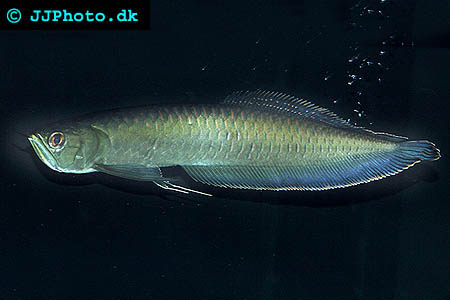
Black Arowana - Osteoglossum ferreirai. Copyright www.jjphoto.dk
Didn't find the info you were looking for? Ask your question in our Aquarium forum !
Our knowledgeable staff usually responds to any question within 24 hours
Predatory fish articles
Alligator Gar - An article about Alligator gars in the wild, and some of the treats to the alligator gar population.
Arapaima fish - An introduction to Arapaima fish, also know as pirarucu
Arowana fish - An article about Arowana fish
Asian Arowana - An article about the asian arowana
Asian Snakehead Fish - An introduction to Asian Snakehead fish
Bichirs - Information about Bichirs
Black piranha - Information about the Black piranha
Breeding Bichirs - Information about Breeding Bichirs
Breeding Piranhas - a short review - a short review
Channa aka frankenfish - Information about Channa aka frankenfish
Channa bleheri / The Rainbow snakehead - Channa bleheri.
Datnoids - Information about Datnoids, also known as dats and siamese tigers
Environmental effects of Snakeheads - Information about the Environmental effects of Snakeheads
Freshwater Moray eels - keeping freshwater Moray eels
Freshwater Pufferfish - Information about different species of freshwater pufferfish
Freshwater Sawfish - An introduction to freshwater swordfish and their present endangered status.
Keeping Gars - A short review - Basic Gar trivia
Keeping Pirhana fish (piranha) in aquarium - Information about Keeping Pirhana fish in aquarium
Keeping Snakeheads in Aquariums - Information about Keeping Snakeheads in Aquariums
Lung fish - Information about Lung fish
Needlefish - An introduction to Needlefish
Payara – Vampire Fish - Information about Payara – Vampire Fish
Piranha keeping for Beginners - Different species of Pygocentrus and Serrasalmus are commonly kept. Their characteristics, tank and living requirements,
Pirhana - Information about Pirhanas
Porcupine puffer fish - An introduction to Porcupine puffer fish
Pufferfish - An introduction to Pufferfish.
Silver Arowana - An article about Silver Arowana
Snakehead fishing - Information about Snakehead fishing
Snakeheads - Information about Snakeheads
Toadfish - An introduction to Toadfish
